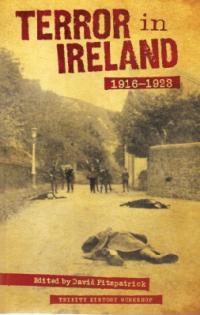Terror in Ireland 1916–1923 David Fitzpatrick (ed.) (Lilliput Press/Trinity History Workshop, €15) ISBN 9781843511991
Published in Book Reviews, Issue 3 (May/June 2012), Reviews, Revolutionary Period 1912-23, Volume 20
Terror in Ireland 1916–1923
David Fitzpatrick (ed.)
(Lilliput Press/Trinity History Workshop, €15)
ISBN 9781843511991
The provocative title of this book immediately challenges readers to think about what they consider terror to be, and what defines a terrorist. This volume, the fifth to be produced by the Trinity History Workshop, sets out to examine the role of revolutionary and counter-revolutionary terror in Ireland between the 1916 Rising and the Civil War. In his introduction to this collection of thirteen essays David Fitzpatrick argues that anyone who seeks to inflict terror on their opponents to achieve a political or military end is a terrorist. It can therefore be argued that all the forces involved in the Irish Revolution at some stage were guilty of committing acts of ‘terrorism’ or ‘state terror’.
Brian Hanley’s contribution, ‘Terror in twentieth-century Ireland’, acknowledges that the term ‘terror’ and its derivative ‘terrorist’ are usually problematic and pejorative. He succinctly and expertly analyses the use of these terms in modern Ireland, scrutinising recent interpretations of the period that have been put forward by historians and politicians. Fearghal McGarry covers similar ground in his excellent piece ‘Violence and the Easter Rising’. But it is the nature of the guerrilla war that followed that has provoked some of the most heated historical debates of recent years.
The Bloody Sunday killings in Dublin are examined in ‘English dogs or poor devils?’ by Jane Leonard. Although Leonard also mentions the fatalities inflicted by the Crown forces, her main focus is on those killed by the IRA that morning. She argues that a number of the British army officers specifically targeted for assassination were not involved in intelligence work, and uses a wealth of biographical detail to support her case. She shows that a number of those killed were officially employed in more mundane posts in the British army, including court martial, engineering and educational officers. This evidence is highly ambiguous, however, since intelligence officers frequently used these positions as cover for their own activities. It is interesting to compare Leonard’s impressive research with the recently published work of J.B.E. Hittle, a US intelligence veteran and historian, which concluded that all but two of the officers shot on Bloody Sunday were connected with British intelligence.
Eunan O’Halpin also analyses the events of Bloody Sunday in ‘Counting terror: Bloody Sunday and the dead of the Irish Revolution’. O’Halpin examines the deaths of civilians and members of the IRA who were killed the same day by Crown forces. Using information and statistics from his forthcoming The dead of the Irish Revolution, he puts all the deaths of Bloody Sunday into context, showing that the Dublin killings were a unique event in the War of Independence. O’Halpin provides some very interesting statistics on the nature of violence in Ireland between 1917 and 1921, including a fascinating breakdown of the number of military and civilian deaths that occurred during the conflict.
The book is dedicated to the late Peter Hart and addresses some of the most controversial and important aspects of his work, including the Kilmichael ambush, the execution of alleged spies by the IRA’s West Cork Brigade and IRA activity in England. Eve Morrison’s chapter, ‘Kilmichael revisited’, re-examines the now famous (infamous?) Kilmichael ambush. Morrison introduces new material to the debate, quoting from privately held tape-recorded interviews of Kilmichael veterans conducted by Fr Chisholm in 1969. She also brings her extensive knowledge of the Bureau of Military History (BMH) to bear.
Morrison’s chapter cannot, however, be said to have demolished Tom Barry’s account of the ambush. Some of the eyewitness testimony quoted by her, including Ned Young’s interview with Fr Chisholm (p. 168) and Tim Keohane’s BMH statement (p. 167), indicates that Barry and some of his men did believe that members of the Auxiliary patrol killed at Kilmichael had used a false surrender tactic.
Given the conflicting testimony of Kilmichael veterans and the fighting conditions involved, a definitive account of the ambush will probably never be written. In recent years the Kilmichael controversy has grown to become a wider debate about historiography. Unfortunately Morrison fails to address the serious questions regarding Hart’s methodology, and in particular his claim to have interviewed an unnamed Kilmichael veteran at a time when all known participants in the ambush were dead.
The controversial topic of the execution of alleged spies and informers in West Cork is investigated by Thomas Earls Fitzgerald, who makes very good use of a wide range of sources, including BMH accounts, press and police reports, to examine each case in detail. Whilst he detects that some members of the IRA in Bandon were hostile towards Protestants, he concludes that those executed by the IRA were usually killed because they were under suspicion and not simply because of their religious profession. Gerard Noonan’s impressive ‘Republican terrorism in Britain 1920–1923’ looks at a very important aspect of the Irish conflict that has been neglected for too long by historians.
Although academic in content, the essays are very clearly written and easily accessible. In summary, this book is a fine collection, comprising some excellent research, which will be enjoyed by both scholars and casual readers. Terror in Ireland certainly lives up to the claim made on its back cover that ‘all those interested in the Irish Revolution will find both provocation and enlightenment in this work’.
Pádraig Óg Ó Ruairc is a Ph.D student at the University of Limerick.
















